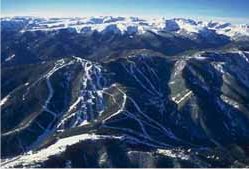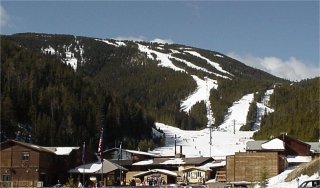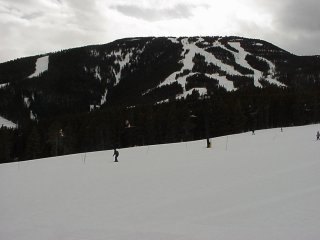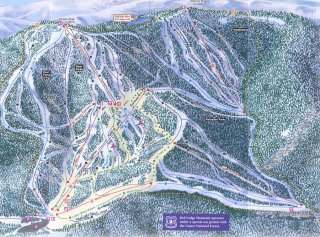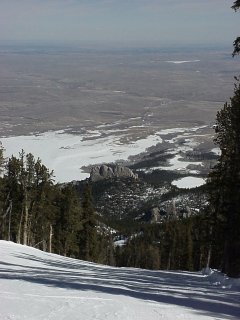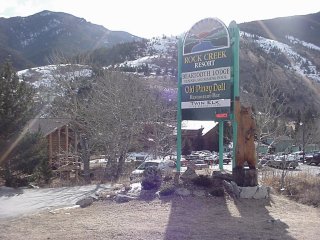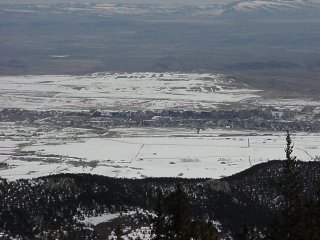Photos by Marc Guido
Red Lodge, MT – Winding southeast through the Montana
countryside on state Highway 78 towards the town of Red Lodge, the eponymously
named ski area above town flashes into view about half way through the 60-mile
trip from the interstate. This sight is fleeting, however, serving only as
a tease until just before you hit town, when the entire resort finally comes
into view and stays there. This is perhaps a fitting allegory for Red Lodge
Mountain’s figurative location, on the outskirts of the collective consciousness
of the destination skiing public.
n
|
|
Situated as it is on the very Eastern edge
of Montana’s rugged Beartooth Mountains, Red Lodge lives in relative isolation,
drawing an average of 125,000 skiers and snowboarders annually primarily from
the metropolitan lightweights of Billings, MT and Cody, WY. Like many former
mining towns, the primary economic drive behind Red Lodge these days is tourism.
Thanks to its proximity to Yellowstone National Park, legions of summer visitors
travelling over the spectacular Beartooth Highway swarm the town. In fact,
Red Lodge Mountain’s raison d’etre when it was financed and opened
by the townspeople in 1960 was to draw visitors during the winter off-season
when both Yellowstone and the Beartooth Highway are closed, despite the fact
that no fewer than five ski areas existed in the Red Lodge area in the 1930s.
The product of their hard work is a sneakily large, surprisingly challenging,
and overwhelmingly friendly skiing and boarding experience. Even in the midst
of one of the poorest snow years for as long as most locals could remember,
Red Lodge provided a varied assortment of nooks, crannies, and thrills to
keep even the most experienced of big mountain skiers and riders interested
for day after day.
After winding our way up six miles worth of
twisty access road from town, the day started out in the base area of the
original trail pod amongst numerous North Dakota and South Dakota license
tags; Red Lodge is the first ski area of any significance as one heads west
from the Great Plains toward the Rockies. Until 1997, the 900 acres and 2000
vertical feet on Grizzly Peak were all that Red Lodge had to offer – not that
there was anything to be ashamed of, mind you. This portion of the mountain
is blessed with terrain that is naturally separated into distinct sections
corresponding to different levels of difficulty. The very bottom of the mountain,
served by the Miami Beach double chair and the Mighty Mite handle tow, is
almost exclusively comprised of beginner runs. Their nearly complete separation
from the rest of the trails, along with Red Lodge’s longstanding commitment
to teaching the next generation of visitors, combine to create a nearly ideal
learning experience for new skiers and riders of all ages.
Heading further up the hill on the Triple
Chair and the Willow Creek double, an interesting mix of beginner, intermediate,
and even some mild expert terrain unfolds below you. For some quick cruising
fun, head on over to Lower Continental or Turnpike or go the other way and
hit the bumps on Royal’s Run. You can also explore the two terrain parks
that Red Lodge maintains on Bobcat and Cariboo.
On top, the Grizzly Peak double serves up
by far the most interesting terrain in the older basin, not to mention spectacular
views of the vast Great Plains to the East and the glacier-scarred Beartooth
Range to the West (they don’t call it Big Sky Country for nothing). To far
skier’s right, you have Barriers and the Lazy M, Red Lodge’s signature intermediate
cruising run. This trail gets a fair amount of traffic because it is one
of the few ways down from the top for non-experts, but the abundance of black
on this section of the trail map helps to ward off a lot of traffic and keep
the crowds down to manageable levels. As such, a fast cruise down the perfectly
pitched Lazy M is almost irresistible. Over to skiers’ left, you are greeted
with a selection of mostly tame single black runs, though the twists and turns
offered by Upper Continental, Berry’s and Boomerang definitely keep things
exciting.
It is straight down the middle where you begin
to get a feel for the hidden underside of Red Lodge. Here, the double black
offerings of East and West Parks, Drainage, and Intimidation unfold in a state
of almost complete anarchy. That is to say that the vast majority of terrain
in this section consists of truly expert glades and chutes that allow skiers
and riders to roam where they please. In a normal snow year, we could have
stayed within this drainage for days on end enjoying the seemingly limitless
options on offer to get down to the Midway Express double. However, in the
three months preceding our March visit, Red Lodge had received a grand total
of 20 inches of snow, thereby limiting the glade skiing opportunities somewhat.
Nonetheless, the skiing both in these trees and out on the trails was surprisingly
good. Thanks in part to its predominantly northern exposure and northerly
latitude, Red Lodge holds snow better than nearly any other ski area this
correspondent has ever seen.
|
Online Video View Northern Lights, a First Tracks!! Online exclusive. Filmed entirely on location at Red Lodge, Big Sky, Bridger Bowl, Jackson Hole and Grand Targhee. (Running Time: 4:36) |
|
|
These conditions were no doubt aided by the
massive expansion of the snowmaking system on virtually the entire Willow
Creek side of the mountain that debuted in 1997, the first significant investment
in the mountain after years of stagnancy fueled by lean snow years, a weak
economy and ample competition for the skier’s dollar (the opening of Big Sky Resort and Bridger Bowl’s addition
of expert terrain on The Ridge siphoned off much of Red Lodge’s Billings traffic).
Fortified with a nearly 15 million-gallon reservoir, the system was transformed
from an afterthought to a network covering fully 40% of Red Lodge’s terrain.
Clearly, Red Lodge’s snowmakers had taken advantage of the frequent cold weather
to lay down layer upon layer of smooth, carvable white carpet.
This, however, was only one portion of Red
Lodge’s master plan expansion of the last five years. The second and even
more impressive component was the 800-acre Cole Creek expansion occupying
an entire drainage to the North of the original terrain. This expansion nearly
doubled Red Lodge’s skiable acreage while increasing its vertical drop by
400 feet to the current 2,400 and provided the area with its first large swathes
of truly expert terrain.
It is in this drainage that we spent the majority
of our time at Red Lodge, lamenting that neither the snow cover nor our schedule
allowed us to explore it in more detail. Unfortunately, the triple whammy
of a poor snow year, frequent northeasterly winds, and the inability to make
snow in this drainage due to obscure state regulations governing water rights
meant that the entire Palisades area was closed on this visit. This is a
shame, because with a mix of true expert and intermediate terrain served by
its own detachable quad, this trail pod promised no shortage of thrills.
|
|
That said, being confined solely to the 1,400
verts of the Cole Creek quad is as good a consolation prize as I can think
of. The narrow natural half-pipes of Coal Chute and Sluice Box provided run
after run of hair-raising excitement while the steeps of True Grit were more
than worthy of its double-black rating. My personal highlights were Hellroaring
and Latigo. The former drops down to the base of Coal Creek in giant steps,
twisting and turning along the way. The latter is a beautifully pitched intermediate
screamer with various rolls and tree islands. Taking this trail in all of
four turns at Mach 2 got my adrenaline running faster than you can say The
Herminator.
Alas, the vast glades and chutes of Headwaters,
East and West Side Mines, Buckin Chute, BigBear Gulch and everything in between
were off-limits due to the paucity of snow cover. This was truly a shame
because the entire upper half of the Coal Creek drainage features trees that
are naturally spaced for a perfect glade skiing experience. I spent much
of the day wiping the saliva off my jacket just looking at all the goods I
could see, but not touch. Still, the Coal Creek drainage’s northerly aspect
served to retain what little snow had fallen in recent months and we were
able to enjoy the open terrain without worrying about destroying our bases.
One of the truly memorable aspects of Red
Lodge is its ability to offer big mountain skiing while retaining the friendly
feel of a locals’ hill, and this feeling on the mountain extends down into
the town as well. Seldom have we, as visitors, been made to feel as welcome
by locals as we were in Red Lodge. What started off as cocktails in the bar
at the Rock Creek Resort, for
example, transformed into closing-hour longnecks with the Rock Creek staff
at watering holes in town. During dinner at the Carbon County Steakhouse,
the owner was our bartender and waitress, while her daughter bussed our table.
All treated us as if they’d known us for years.
|
|
Downtown Red Lodge is primarily comprised
of a stereotypical western Main Street flanked by several residential blocks
on either side. Restaurants, taverns and stores (not the intentional choice
of the word “stores” over “boutiques”) line its length, catering to the year-round
visitor traffic, while several hotels and motels dot the ends. Remains of
abandoned coal mines ring the town, and you’ll find no faux western town in
Red Lodge – this is the genuine article. Buffalo Bill Cody, Calamity Jane,
Liver Eatin’ Jonston and the Sundance Kid were all spotted here in their day.
The aforementioned Rock Creek Resort, however,
lies six miles south of town toward the Beartooth Pass. Founded by Vail heavyweight
Pepi Gramshammer, Rock Creek Resort was originally developed to provide housing
for participants in Gramshammer’s summer race camps up on the Pass. Now,
however, it accommodates guests in lodging units ranging from standard bedrooms
to private cabins. Our three-bedroom, 2.5-bath townhouse was priced at an
eminently reasonable nightly rate of $295 when you consider that it sleeps
6. The on-property Old Piney Dell restaurant has a nearly 60-year history
of fine dining in these parts, and Rock Creek’s conference facilities can
accommodate groups of up to 375 participants.
Despite the town’s amenities, back up on the
hill, the base area is minimalist – just a base lodge and a few skier services
and administration buildings. The lodge is a little Spartan, but functional,
while the outdoor BBQ replete with a loudspeaker blaring my favorite 80s hits
was a personal favorite. Future plans call for a revamping and expansion
of the base area in order to bring it up to more modern standards. As long
as a distinct day lodge remains, a certainty with the high percentage of local
skiers, there is no threat of this development running rampant. There is
also talk of real estate development in the near future atop the Miami Beach
lift replete with a 60-unit hotel and some retail and conference space, along
with some 30 cabins scattered throughout the woods. Thankfully, Red Lodge
lacks both the capital and the ambition to build the cookie-cutter villages
seen elsewhere, so we view this development in a positive light. Although
289 shareholders own the mountain, including many downtown businesspeople
that don’t even ski, two families who don’t always see eye-to-eye own over
80% of the resort’s stock. Any further expansion of the skiing terrain will
have to wait for a proven need, although the master plan envisions a high-speed
quad running right up the main drainage from the existing base area to the
top of Grizzly Peak. Rumors float through town of a possible resort purchase
and subsequent development of a mountain village in open land beneath the
Palisades chair, but rumors will always run rampant through such a tight-knit
community of only 2,300 residents, and we were unable to confirm or deny their
validity during our visit.
In the meantime, visitors will have to content
themselves with a genuine western town replete with friendly locals, a large
ski hill with few crowds and challenges for every ability, and a local-hill
feel that is often strangely absent out West. It sure is a combination that
I could learn to live with – it just takes a little while to find.

